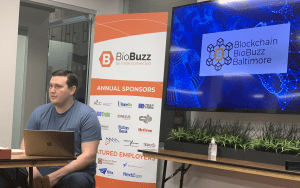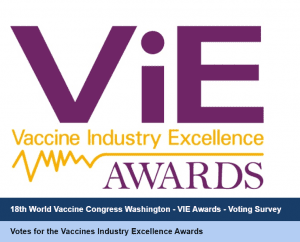
Advancements In Gene Editing and CRISPR Emerging From Frederick, Maryland’s Vibrant BioHub
A strong crowd of BioHealth Capital Region (BHCR) lab researchers, genomic scientists, and other life science industry members were drawn to the Frederick National Laboratory for Cancer Research’s (FNLCR) to hear from experts at the leading-edge of gene editing and CRISPR research.
“The Cutting Edge: Gene Editing and CRISPR” was yet another great speaker Bioconnector Speaker Series event coordinated by the Frederick County Chamber of Commerce, FNLCR, and Frederick’s Center for Research Education in Science & Technology, also known as CREST. Dr. Raj Chari, Director, Genome Modification Core Laboratory at FNLCR, and Dr. Gregory Alberts, Global Subject Matter Expert in Transfection and Genome Editing at Lonza Pharma Bioscience Solutions were the morning’s featured speakers.
CRISPR-Cas9 has burst on the drug development scene in a serious way in the last three to five years. CRISPR is a powerful, versatile and user-friendly tool that lab researchers started to explore about a decade ago to edit genomes and alter DNA. The technology allows genetic material to be added, “knocked out” (removed) or altered, ideally at particular targets in the genome and in a pre-designed way to meet researchers’ needs. CRISPR is one of the newest gene-editing tools that has risen to prominence and generated tremendous excitement, particularly across the last three years.
While CRISPR is an incredibly promising tool its full potential has been limited due to off-target events that can be dangerous to humans. CRISPR clinical trials in humans are very rare, with most of its use focused in the laboratory and animal models. This could change if researchers like Dr. Chari and subject matter experts like Dr. Albert can find ways to decrease off-target events by increasing the targeting efficiency of CRISP-Cas9 and other gene-editing approaches.
Dr. Chari’s research focuses, in part, on ways to improve CRISPR’s efficacy and specificity, which means a reduction in potentially dangerous off-target events in humans. He spoke to his most recent research in his presentation entitled, “Harnessing Genome Engineering Technologies to Understand Biology with High Precision.” Dr. Chari discussed the effectiveness of guide RNAs, which are used to identify targets and guide the Cas9 to a specific location for insertion or deletion. As a post-doctoral student at Harvard Medical School, Dr. Chari worked in the lab of Dr. George Church, where he helped develop a sophisticated tool that could predict how well certain RNA guides could edit. This tool is now at the FNLCR and is used by researchers to design better CRISPR experiments (you can read the abstract of Dr. Chari’s findings here). Dr. Chari is at the tip of the spear when it comes to researching ways to improve CRISPR-Cas9’s targeting capabilities, which is critical for CRISPR to be used more frequently in human clinical trials.
Dr. Gregory Alberts’ presentation, “Genomic Editing and Nucleofection, ZFNs, TALENS, and CRISPRs,” discussed three well-known genomic editing technologies in the context of nucleofection, which is an advanced electroporation-based transfection method that enables the transfer of nucleic acids like DNA and RNA into cells. Nucleofection is critical to genome editing and is achieved via the application of reagents and voltage. Dr. Alberts specifically spoke to Lonza Biosciences’ non-viral Nucleofector technology that delivers substrates into clinically-relevant cells with a high rate of success. Lonza’s 4D-Nucleofector™ System is scalable, customizable and an ideal companion technology for genome editing. The system is particularly effective with non-viral gene-editing methods.
This Biotech Connector Series event at the FNCRL’s Advanced Technology Research Facility is just the latest example of Frederick’s strength as a life science hub. Last year’s Tech Transfer Showcase drew life science thought leaders and entrepreneurs from across the globe to Frederick. This year’s Tech Transfer Showcase will occur on June 17th and is sure to be well-attended once again.
Frederick is home to AstraZeneca’s Biologics Manufacturing Centre and a number of biotech and pharmaceutical companies, including a burgeoning startup ecosystem that is supported by a robust incubator infrastructure, strong economic development organizations at the City and County levels and highly effective workforce development programming across Frederick County.
To learn even more about how Frederick is leading the way in biomedical research, innovation and commercialization watch the video below.
The Frederick Innovative Technology Center or FITCI is the epicenter of this growing biotech hub; the organization has produced a number of outstanding companies, including one-time FITCI startups like RoosterBio, Inc. and BioFactura, Inc., that have emerged as prominent regional life science companies over the last several years. Other Promising companies like Akonni Biosystems, Theradaptive, Veralox Therapeutics, NanoBioFab, and Dri Biosciences, among many others, also call Frederick home.
Frederick, Maryland remains a thriving biohub with a remarkable mix of big pharma companies and emerging biotech, personalized medicine, MedTech, and medical device organizations. Frederick has become a destination of choice for many new startups as well as established life science companies seeking a new home near key institutions and with a strong economic and workforce support infrastructure.
- About the Author
- Latest Posts
Steve brings nearly twenty years of experience in marketing and content creation to the WorkForce Genetics team. He loves writing engaging content and working with partners, companies, and individuals to share their unique stories and showcase their work. Steve holds a BA in English from Providence College and an MA in American Literature from Montclair State University. He lives in Frederick, Maryland with his wife, two sons, and the family dog.







